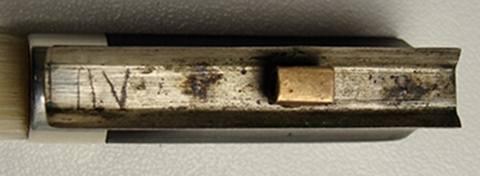STRASBOURG, MIRECOURT AND OTHER STORIESThe bow on the photograph below takes part of the array of bows without name. It is a bow of very high quality and a fluke of Mº Ilya Grubert – but was it only fortune? Anonymous Bow France/Germany 1830/35 This object is the physical demonstration of the how silly the saying “one can't live by culture” is – a statement done by a politician not long ago. I sustain it is necessary to have some knowledge and preparation in culture, to enter a little antique store in Amsterdam and with a small amount of money leave with such a bow. This bow, which is definitely partly French, has been bought for 800 euros. Even if the stick should be German - on the contrary to what I believe - we are talking about a ten time increase of value. Therefore having spent 2000 euros on the book “L'Archet” and some time browsing it, not only has Mº Ilya Grubert, payed the bow and his dinner, he has also a little something for his summer holidays. Obviously it has been less onerous to MºGrubert, than it would be to a student to buy a book of such a cost. Imagine though if every Conservatory could have a copy of this book available to its students, or if students had the possibility to attend a course in history and mechanics of stringed instruments held by a professional violin or bow maker. Do not misunderstand me, I am not pleading for a job, but it often happen that I find myself in front of parents scammed by “masked” merchants – as I call them – saying - “My husband and I are not violinists and unfortunately we trusted this person. As well as an economic damage, who possesses and uses incorrect made bows or instruments learns to play with a wrong position, which often causes important muscular damages. Finally the quality level of the sound of our students; it is a difficult period because students listen to music on cd's more than at live concerts which contributes to a distorted idea of a beautiful sound. Of course, an initial investment has to be made, an investment which by my opinion will be rewarded though. A higher level of musicians, who other than being able to produce a more beautiful sound, will have a weapon against fraudsters. They will find themselves with more money to invest – maybe more money in their pockets. Now the bow. Closure of the chamfer on the bow head - the French way The first thing one note is the type of wood of the bow; light brown of media density. A kind of wood used in the beginning of period of bow making, especially in France. This particularity had struck M° Grubert too. The bow has an antique curve which is pulled very. A fact that leeds to date the bow earlier than 1850. Closure of the chamfer on the bow head the French way - Upper View Triangular tip - the French way The geometry of the bow head leeds to state this period as well. It is really very well cut, except of the chamfers - particularly the right chamfer. The chamfers have small bursts, probably due to some fibers particularly hard in that point. The bow head leaves several clues of its origin. The tip in ivory has a triangular profile which is a classic example of French style. The line of the front chamfer of the bow head does not stop on the wood but continues half way down the ivory, as you can see on the photo with the three quarter view of the bow. You note it from the upper view as well; because of the chamfers, two small indentations are formed just before the arrival on the ivory tip. This is pure French style. Ivory tip There are more certainties when considering the frog, and M° Raffin, has confirmed my assessment; Mirecourt origin, the Pajeot school. To tell the truth it wasn't that difficult to place the frog. The ebony is of the finest quality, the thickness of the ring and the drawing of the throat recalls Etienne Pajeot if you look close. Furthermore the drawstring is different to the ones used usually. This model of drawstring where the silver covers the head of the pallet, was a small failed invention by Pajeot, to reduce the use of ebony, used from 1830 to 40. Obviously this is not a Pajeot. Despite the bow is carried out very well, there are still some geometric imperfections, like the position of the eyes which are not perfectly centred relative to the throat. The drawstring is fixed with two small tacks. It has a roman number engraved which tells us that the bow comes from a mass production - although the bow is of a good level.
The mortise has a typical French design as well; if you recall, the German ones are inscribed in the face of the head of the octagon. The bow is branded Bausch, but false. The stick has been located as French, but as mentioned earlier I agree with M° Raffin, relating to the German origin of the stick. To plead my case I would point out that the bow is similar to a Schwartz photographed in their book. A smiling answer: - “Well yes, Schwartz was not exactly French.” - To read more about this topic: ETIENNE PAJEOT; THE TOUSAND HEADED BOW MAKER GEORGE FREDERIC SCHWARTZ; THE MESTIZO So long, Paolo
|
   |






